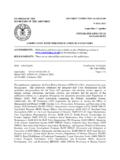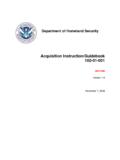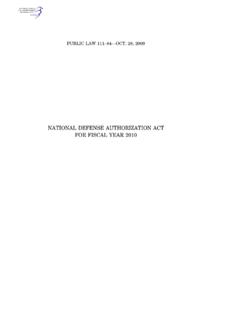Transcription of OPTIMIZING SUSTAINMENT OF ARMY SYSTEMS 1
1 OPTIMIZING SUSTAINMENT OF army SYSTEMS 1. Defense Acquisition University Senior Service College Fellowship 2015 2016. Research Paper OPTIMIZING the SUSTAINMENT of army Weapon SYSTEMS Written By Curtis D. Gross This research paper is presented to the Defense Acquisition University in fulfillment of the Senior Service College Fellowship Program academic requirement (research paper) under the direction of SSCF Director John Daniels and Research Advisor Dave Treshansky. Distribution Statement A, Approved for Public Release, 31 March 2016, army Aviation &. Missile Command Public Affairs Office . 17 March 2016. Huntsville, Alabama OPTIMIZING SUSTAINMENT OF army SYSTEMS 2. Approval Page Title: OPTIMIZING the SUSTAINMENT of army Weapon SYSTEMS Author: Curtis D.
2 Gross Date of Paper: 17 March 2016. Research Advisor (Dave Treshansky) Approval Date: 1 March 2016. Research Paper Reviewer (John Cannaday) Reviewed Date: 15 March 2016. Research Paper Reviewer (Dana Stewart) Reviewed Date: 15 March 2016. SSCF Director (John Daniels) Approval Date: 17 March 2016. OPSEC (USSAMCOM) Approval Date: 31 March 2016. Approval for Public Release Date: 31 March 2016. Date Submitted for Journal Publication: OPTIMIZING SUSTAINMENT OF army SYSTEMS 3. Abstract The army has drawn down its Operational Tempo in two theaters of operation: Afghanistan and Iraq. Contingency operation funding is also being drawn down and its availability is based on strong needs justification. Future SUSTAINMENT of army managed manned and unmanned air and ground weapon SYSTEMS is a critical topic not only within the army Acquisition and SUSTAINMENT communities, but also within the Operational and Institutional army .
3 The research will provide courses of action to be considered to answer the question "How can the army optimize post war system SUSTAINMENT support? . A literature review was conducted to identify statutes, regulations, policy, and procedures which form the framework of current army weapon system SUSTAINMENT . The review provides insight into the processes the army uses to identify capability gaps and methods used to address these gaps. The research considered SUSTAINMENT issues identified by strategic army documents such as the army 's Capability Needs Analysis (CNA), the army Long-range Investment Requirements Analysis-18 (LIRA-18), and the Joint Acquisition and SUSTAINMENT Review (JASR) Memorandum, signed 3 Dec 2014, by the Assistant Secretary of the army (ASA) for Acquisition, Logistics, and Technology (AL&T), and the Commanding General (CG), army Materiel Command (AMC).
4 Qualitative and quantitative data was collected and analyzed from the communities involved in the SUSTAINMENT of army weapon SYSTEMS . The analysis of the collected data was used to craft possible Courses of Action for consideration by Senior army leaders. OPTIMIZING SUSTAINMENT OF army SYSTEMS 4. Contents Abstract .. 3. Chapter 1 - OPTIMIZING the SUSTAINMENT of army Weapon 6. Problem Statement .. 11. Significance of 11. Figure 1: S&T Lines of 13. Chapter 2 Literature Review .. 14. DoD Directive , The Defense Acquisition system (DAS) .. 15. DoD Instruction , Operation of the Defense Acquisition system (DAS) .. 15. army Structure Memorandum, 15 19, September 2013 .. 15. United States army Regulation (AR), AR-70-1, army Acquisition Policy.
5 16. AR 700-127, 7 Oct 2014, Integrated Product Support .. 17. AR 700-142, 2 Jun 2015, Type Classification, Materiel Release, Fielding, and 18. ASA (AL&T) Memorandum, 27 May 2014, Subject: Management and Analysis Review of Contractor Support of Materiel .. 19. ASA (AL&T)/AMC Memorandum, 3 Dec 2014, Subject: Joint Acquisition and SUSTAINMENT Reviews (JASRs) .. 19. Product Support Manager Guidebook, April 2011 .. 20. Combined Arms Support Command, 30 Aug 2013, Subject: army 2020 and Beyond SUSTAINMENT White 21. ASA (AL&T) Memorandum, Operations and Support Review, 29 Apr 2015 .. 21. Capability Needs Analysis (CNA) .. 22. army Forces Command (FORSCOM) G-4 Logistics White Paper 22. Long-range Investment Requirements Analysis (LIRA).
6 24. Defense AT&L Magazine, Jan-Feb 2014, Thirty Year Plans: What They Are and Why We Need Them .. 25. AMC History: army Materiel Command (AMC) and the Goldwater-Nichols DoD Reorganization Act of 1986 .. 25. army Logistician, Mar - Apr 05, Life-Cycle Management: Reducing the Burden on the Soldier .. 26. Chapter 3 Research Methodology .. 27. Desired Outcome .. 28. Limitations of the 28. Chapter 4 Findings .. 29. Figure 2. Survey Participation Consent Data: All 42 Participants Consented .. 30. Figure 3: Respondents Gender Results .. 31. OPTIMIZING SUSTAINMENT OF army SYSTEMS 5. Figure 4: Respondent Age Groups .. 31. Figure 5: Number of Years of Acquisition/Logistics Experience .. 32. Figure 6: Myers-Brigg Type of 32.
7 Figure 7: ACAT Program Level Managed or Supported .. 33. Figure 8: Current Military Rank/Civilian 33. Figure 9: Education Level .. 34. Figure 10: Training/Fellowship Programs Completed or Participating In .. 35. Figure 11: army Civilian Education Courses Completed .. 36. Figure 12: Primary DAWIA Career 37. Figure 13: Respondent DAWIA Certification Level .. 38. Figure 14: Acquisition Corps Membership .. 38. Figure 15: Respondents Current Parent Organization .. 39. Figure 16: Acquisition Integrated Product Team Leader/Member .. 40. Figure 17: Acquisition IPT Meeting Frequency .. 40. Figure 18: SUSTAINMENT IPT 41. Figure 19: SUSTAINMENT IPT Meeting Frequency .. 41. Figure 20: Inter-organizational Weapon system Support Synchronization Meeting 42.
8 Figure 21: Effective LCMC PEO/PM Collaboration Effort Effectiveness .. 43. Figure 22: Participation in RAC, Jr. RAC, Requirements Planning Meeting .. 44. Figure 23: Knowledge of SSTS Funding Flow .. 44. Figure 24: Prioritization of SUSTAINMENT 45. Figure 25: SUSTAINMENT Funding Level Information 45. Figure 26: PPBE Training Interest .. 46. Chapter 5 - Discussion and 47. Recommendations .. 53. References .. 56. Appendix A Acronyms .. 60. Appendix B Survey Questions .. 64. OPTIMIZING SUSTAINMENT OF army SYSTEMS 6. Chapter 1 - OPTIMIZING the SUSTAINMENT of army Weapon SYSTEMS In a paradigm shift from the past 13 years of war, more army SYSTEMS transitioning to SUSTAINMENT support will be maintained by the Soldiers using that piece of equipment and not contractor personnel.
9 In his recent discussions with army Senior Warrant Officers at the first ever army Senior Warrant Officer Summit, army Material Commander, General Dennis Via stated: With a shrinking end strength and budget, the army will need to relearn how to sustain what it has, rather than depend on contractor logistics support or replacements (Lopez, 2015). Soldiers performing maintenance on their own equipment is a task that has been a secondary priority at best during the past 13 years of war. Recurring deployments and mission Operational Tempo (OPTEMPO) in two Areas of Responsibility (AOR) resulted in a decision by Senior army leadership to require Soldiers to focus on Common Soldier Skill Tasks during the past 13.
10 Years. The result has been the erosion of perishable maintenance skills. The army must develop the most effective plan to sustain these SYSTEMS at peak readiness. Studies of how to adjust maintenance schedules using Condition Based Maintenance (CBM) data and corrosion control efforts from the Department of the army level down to the field Commanders are meant to provide Senior army leaders with options to reduce SUSTAINMENT , and replacement costs. As evidenced by the referenced material, there is an ongoing effort within the SUSTAINMENT , research, acquisition, and commercial communities to study and effectively manage army SUSTAINMENT . One effort is the development of Maintenance Steering Groups (MSG) to perform extensive data collection and analysis of currently fielded SYSTEMS to craft effective and efficient Scheduled Maintenance Programs (SMP).















